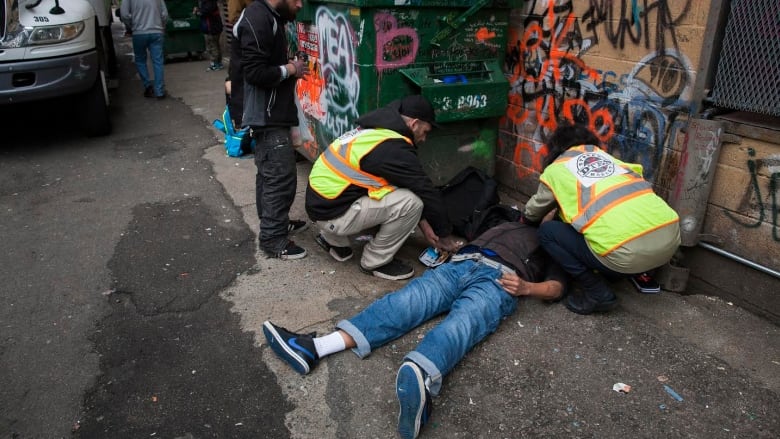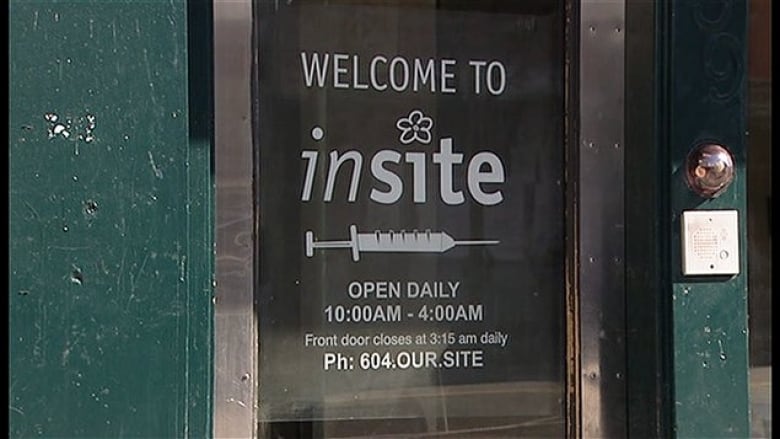Activists bring more pop-up injections sites to Vancouver's overdose 'battle zone'
'Everybody is going full-tilt and it's just not enough. People are dying,' says activist Sarah Blyth

The overdose crisis is turning Vancouver's Downtown Eastside into a virtual 'battle zone' say activists and nurses who are setting up more unsanctioned supervised injection sites in order to save lives.
"Everybody is going full-tilt and it's just not enough. People are dying.It's just reallyshocking," saidSarahBlyth,a volunteer with the Overdose PreventionSociety, which is now operating two pop-up tents on the streets.
The group, which Blyth says formed out of necessity, offers clean needles, food and basic medical care including the administration of overdose prevention drugs such as Narcan to people in immediate need.
Rather than setting up a medical facility in a building like the federally sanctioned Insite supervised injection site, her group is operating on the streets and in the alleys of the Downtown Eastside.
"Really what we are doing is illegal and we didn't ask, but we are saving lives anyway," said Blyth, who notes on Sunday night alone they saved seven lives in an alley near Hastings and Main streets.
We don't have to wait
Blyth said her group responded after so many people kept overdosing up at theDowntown EastsideMarket. So they ignored rules and set up a tent full of supplies creating their first pop-up site.
"We don't have to wait for the government. We don't have to wait for red tape and bureaucratic anything. We can just do this and save lives," said Blyth,
But it costs about $150 a day to run the tents and the government will not fund the illegal pop-up sites.
Nevertheless Blyth hopes to expand. To do that she has started a Go Fund Me page with a $10,000 goal to try to keep pop-up sites open,
- Fentanyl deaths are a Canada-wide 'disaster'
- The new face of fentanyl addiction: Kati'sstory
- 'Too toxic to touch': Police struggle to deal with fentanyl
But she says that still won't be enough.
"It's just really sad for me to see and really depressing," said Blyth, who fears when the next round of social assistance cheques come, there will be another wave of people dying on the streets.
"We have to have more boots in these alleys right now. These pop-up tents seem to be working," said Blyth.
Red tapes needs to be ripped away
Like many activists like Blyth remain frustrated and says federal red tape that hampers the creation of life-saving injection sites needs to beripped away.
And it is not just in Vancouver that fatigued nurses and front-line volunteers are urging Ottawa to declare the wave of opioid-related deaths a national crisis.
"It is hard to see your patients dying in large numbers. This is a lot of stress for providers on the frontline," said Marilou Gagnon, with the University of Ottawa school of nursing andfounder of a coalition of nurses and nursing students pushing for more supervised injection sites.
175 overdoses in 5 days in Vancouver. What are we doing to support nurses on the ground? https://t.co/LbgF0okXzT #nurses #opioid #OCO16
—@mlgagnon_XVII"It is like a daily battleground. To be exposed every day to this kind if stress and challenges it's hard," said Gagnon.
She supports the pop-up injections sites as a "rapid response" to the crisis at hand, but adds that the model is not sustainable.
Gagnon says health workers are so busy they do not even have time to speak up. She's calling on nursing associations and advocates to get louder.
'Numbers are just excessively high'
Meanwhile there were a least 14 overdoses reported on Sunday according to Neil Arao of Insite, one of two official supervised drug injection sites in Vancouver, which recently extended its hours to manage the demand from the street.
"These numbers are just excessively high," said Arao, who says a purple-hued substance seen last week on the street is suspected to be the culprit in some of the overdoses.
In total there were 175 overdoses in the past five days in the troubled neighbourhood, according to nursing advocates, but it is unclear how many of the overdoses resulted in deaths.
Across B.C. health officials blame fentanyl mixed into street drugsin the majority of the 622 overdosedeaths between January and October, compared to 397 in the same time period last year.
The BC Coroners Service says they believe fentanyl was involved in 60 per cent those deaths. Likewise testing done by Insite in August revealed that 86 per cent of drugs tested contained fentanyl.
13 overdoses before 8pm tonight at #Insite #opioidcrisis #insitesaveslives @tlupick @VancouverPD
—@InsiteVan
With files from Farrah Merali












_(720p).jpg)


 OFFICIAL HD MUSIC VIDEO.jpg)
.jpg)



























































































